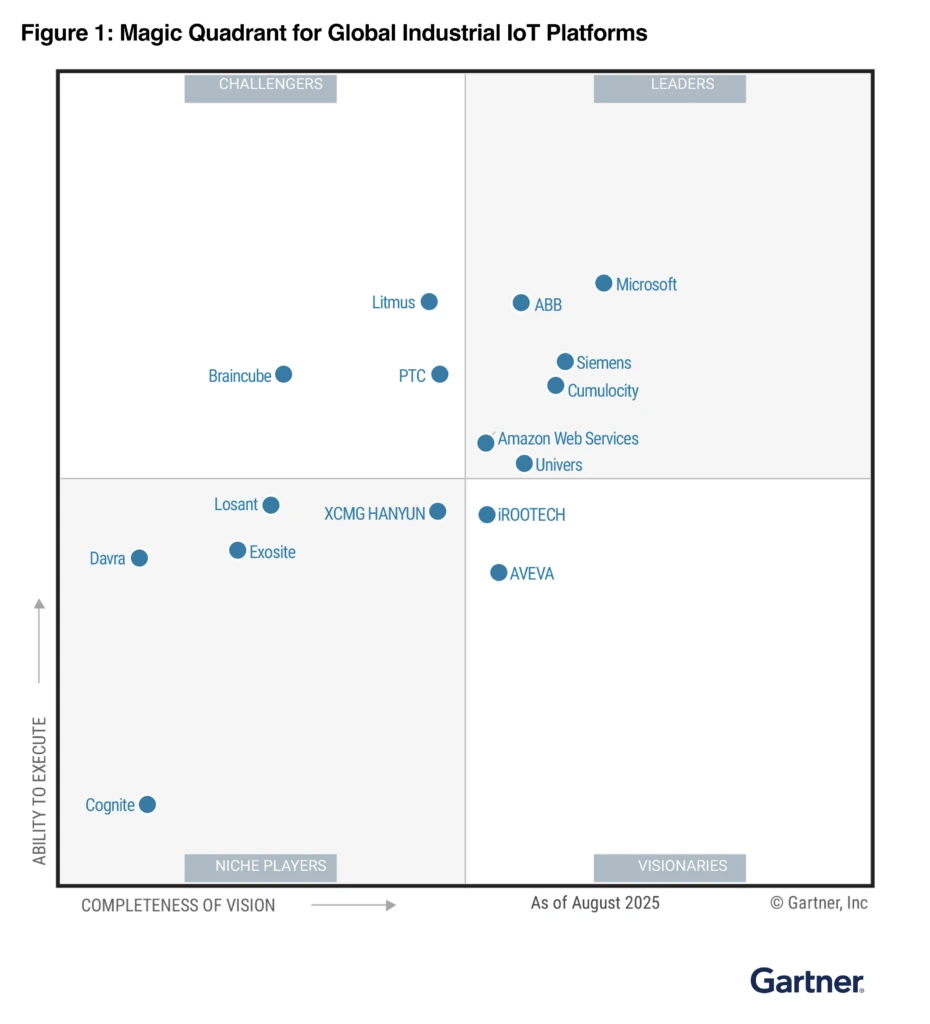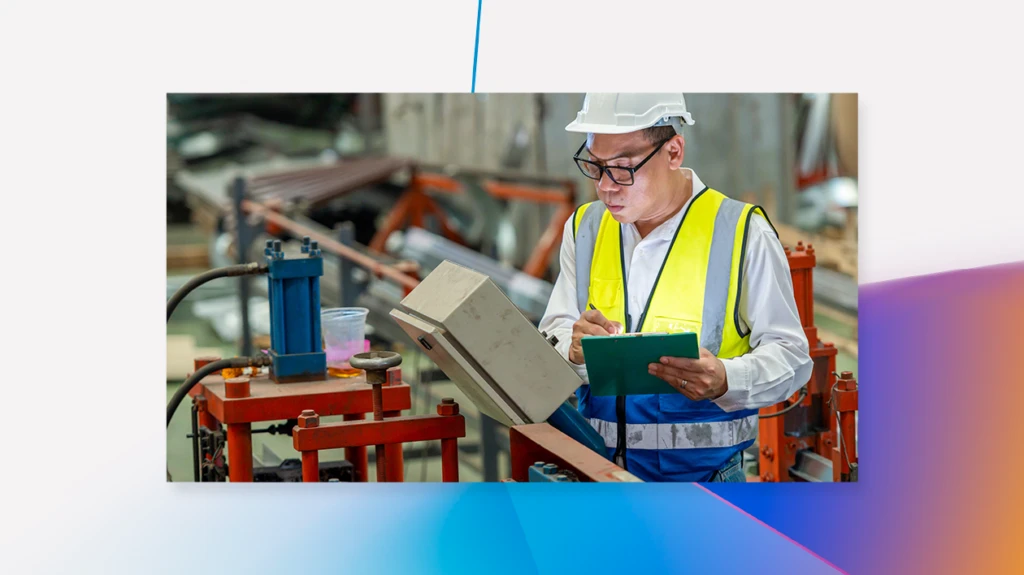We’re proud to share that Microsoft has been recognized as a Leader in the 2025 Gartner Magic Quadrant for Global Industrial IoT (IIoT) Platforms. We believe this recognition underscores our commitment to empowering industries with intelligent, secure, and scalable solutions that drive real-world impact.
As industrial organizations continue to modernize their operations, Azure’s adaptive cloud approach, which includes Azure IoT, Azure Arc, and more, can help manufacturing, energy, and logistics organizations to enhance efficiency, optimize performance, and drive secure innovation at scale.

Recognized in industrial IoT
In today’s data-driven industrial landscape, Internet of Things (IoT) technology already serves as a strategic driver of operational excellence and competitiveness. Connected sensors and edge devices capture machines and process data that can then be integrated with other key enterprise systems such as Manufacturing Execution System (MES), Enterprise Resource Planning (ERP), and analytics in digital twin models to predict failures, optimize asset utilization, and reduce downtime. These capabilities result in business value by helping organizations improve key performance indicators (KPIs) such as quality assurance, energy efficiency, and supply chain traceability.
As the backbone for AI, IoT provides high frequency telemetry and controls the pathways needed for advanced analytics and machine learning. This synergy powers additional industrial use cases like self-dispatching field services, vision-based quality inspection, process optimization, energy load balancing, and intelligent operator assistance. Industrial IoT, especially when deployed with an adaptive cloud approach, can transform AI from isolated pilots into scalable, production-grade capabilities that could boost yield, throughput, and sustainability. These capabilities can help unlock a new type of organization, what we call the Frontier Industrial firm—industrial companies operating at the leading edge of digitalization to pursue superior productivity.
We continue to help industrial organizations transform by focusing on the key areas our customers prioritize:
Comprehensive platform for industrial needs: Microsoft’s industrial IoT platform enables a wide variety of industrial use cases through its ability to bring data from distributed and collocated devices into a common data foundation for analysis and action. Key capabilities include Azure IoT Hub, Azure Digital Twins, Microsoft Defender for IoT, Azure IoT Operations, and Microsoft Fabric. Together, these tools help empower organizations to make data-driven decisions, boost operational efficiency, and scale AI across varied deployment environments.
Industrial data acquisition and management: Microsoft’s focus on standards, ecosystem partnerships, and helping customers take advantage of existing investments are key pillars of its industrial data management strategy. Industrial data acquisition and management are challenging today due to the complexity of industrial environments. To help with this, Azure IoT Operations natively integrates with brownfield environments and enables high-velocity operational technology (OT)/IoT data collection and contextualization using Akri connectors. Once gathered, the data is stored in OneLake using Microsoft Fabric, allowing for unified modeling in a central location.
Azure Arc-enabled Kubernetes extends these capabilities with open-standard APIs that integrate seamlessly with Azure’s cloud management graph (ARM graph), ensuring consistent security, auditing, and policy enforcement. Meanwhile, Azure Device Registry unifies asset management by representing edge assets as Azure resources which lays the groundwork for scalable application deployments.
Real-time intelligence for smarter decisions: Microsoft’s strength in industrial data management is more than just technical, it is transformational. By cleaning, contextualizing, and curating OT/IoT data at the edge, Azure IoT Operations builds a solid foundation for real-time intelligence. Integrated with Microsoft Fabric and Azure Digital Twin Builder, this enables AI-enhanced decision making that helps customers optimize production quality, improve equipment reliability, and support sustainable operations.
Integration with Microsoft Copilot in Azure: Microsoft is redefining intelligence with the integration of Copilot and generative AI capabilities across its IoT platform, especially Azure IoT Operations and Microsoft Fabric. With Copilot in Azure you can retrieve intelligent recommendations for operations management, advanced data analysis, and visualization. This empowers industrial teams to make faster and smarter decisions, whether optimizing workflows, interpreting complex datasets, or managing supervisory tasks.
Cloud-to-edge integration with the adaptive cloud approach: Microsoft’s IoT platform enabled by Azure Arc’s adaptive cloud approach unifies hybrid, multicloud, edge, and IoT environments. This provides a consistent unified control plane for applications, data, and governance that meets industrial needs for scalability and operational efficiency.
Secure by design, intelligent by default: Azure IoT Operations is designed with security at its core. This proactive approach is intended to reduce operational burden for users. Microsoft also has a fully integrated security suite, including Microsoft Defender for IoT, Microsoft Sentinel and Microsoft Entra.
Shaping the future of digital operations
Our roadmap will focus on expanding AI capabilities—including agentic and generative AI—across the Azure stack. We are committed to helping customers harness the full potential of their data, streamline operations, and innovate faster. We remain focused on evolving our platform to meet various industrial needs. As we continue to innovate, our priority is making it easier for customers and partners to build confidently on Azure.
Microsoft has a robust partner ecosystem that can help ensure local expertise and tailored solutions for every industry, to unlock new opportunities and deliver even greater impact. Whether it is co-innovating on industry-specific solutions or scaling AI adoption globally, our partners are essential to helping customers build confidently on Azure.
Learn more
Discover how Microsoft’s IoT offerings can enhance your operations. Explore the resources below for more information-
- Explore Azure IoT portfolio.
- Explore our unified data platform, Microsoft Fabric, and learn more about Digital Twin Builder in Microsoft Fabric.
- Check out our IoT Partner Ecosystem.
Gartner, Magic Quadrant for Global Industrial IoT Platforms, By Scot Kim, Sudip Pattanayak, Emil Berthelsen, Sushovan Mukhopadhyay, Wam Voster, Akhil Singh, September 8, 2025.
Gartner does not endorse any vendor, product or service depicted in its research publications and does not advise technology users to select only those vendors with the highest ratings or other designation. Gartner research publications consist of the opinions of Gartner’s Research & Advisory organization and should not be construed as statements of fact. Gartner disclaims all warranties, expressed or implied, with respect to this research, including any warranties of merchantability or fitness for a particular purpose.
GARTNER is a registered trademark and service mark of Gartner, Inc. and/or its affiliates in the U.S. and internationally, Magic Quadrant is a registered trademark of Gartner, Inc. and/or its affiliates and is used herein with permission. All rights reserved.
This graphic was published by Gartner, Inc. as part of a larger research document and should be evaluated in the context of the entire document. The Gartner document is available upon request from here.

